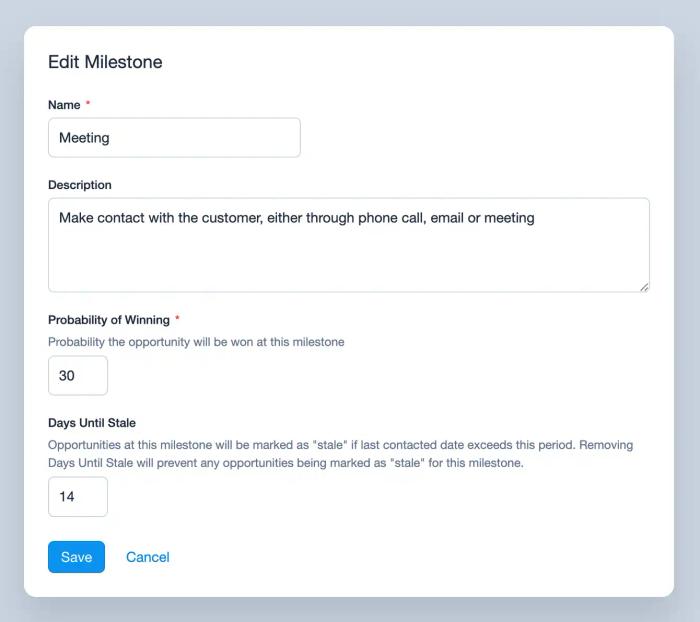If you're in sales leadership, you understand that a strong sales team is your organization's lifeblood.
They're the ones who skillfully navigate potential clients through the sales funnel, closing deals and driving revenue.
But here's the catch – without a structured, repeatable process in place, the entire sales operation can become chaotic and unpredictable. That's where a well-designed sales pipeline, powered by CRM software like Capsule, is incredibly useful.
In this guide, we'll walk you through the steps to create a sales pipeline that not only helps your team navigate common roadblocks but also streamlines the sales process, making it easier to add new prospects and boost your conversion rates.
Why a sales pipeline matters
Your sales team all have one goal in mind and that is to make the sale. However, with each opportunity comes challenges. The sales pipeline acts as a guide as to how to move that sale closer to the goal in the most effective way.
Sales pipelines:
- Visualize the sales process: Break your sales process into logical phases, making it easy for your sales reps to see the big picture.
- Provide guidance: Clearly define each prospect's position within the pipeline, giving your sales team a roadmap for their actions.
- Uncover bottlenecks: Instantly spot any roadblocks in the pipeline, allowing you to address them promptly.
- Balance workloads: Make sure work is distributed evenly among your team with a clear view of who is assigned what.
- Predict sales likelihood: Enable accurate forecasting of closed sales, ensuring a strong conversion rate.
Now, let's identify the steps for creating your first sales pipeline using Capsule.
Step 1: Set up your CRM
While you could track your sales pipeline on a spreadsheet, a CRM like Capsule offers automation and workflow optimization that significantly enhances your sales management.
Capsule CRM provides valuable sales pipeline management features such as:
- Multiple pipelines: Segment your target audience into logical groups and create custom pipelines with corresponding stages for each.
- Drag-and-drop functionality: Easily move prospects between stages of your sales pipeline with a simple click.
- Real-time visibility: Instantly identify productivity issues or unmet quotas within your sales pipeline.
- Timeline management: Set specific timelines for each stage to ensure your team works to keep deals active.
- Velocity control: Visualize your pipeline, allowing you to make informed decisions about adding new sales opportunities.
- Agile reporting: Access in-depth, filterable reports to enhance your organization's agility.
Watch our video to see how you can manage your sales pipeline in Capsule.
Step 2: Define key stages
Conventional workflow documentation can make a sales process seem overwhelming. Our sales pipeline simplifies any process by breaking it down into logical steps that we call Milestones.

Milestones within the Sales Pipeline serve as distinct stages in your sales process, and each one is associated with a 'Probability of Winning,' indicating the likelihood of successfully closing an Opportunity. By default, Capsule provides initial Milestones to kickstart your sales journey, but you have the flexibility to customize them to align with your company's workflow.
As Opportunities progress, you can update the Milestones to reflect their evolving status, typically moving to stages with higher win probabilities until the Opportunity is either won or lost.
This Milestone percentage, in conjunction with expected values and close dates for active Opportunities, enables you to forecast your potential sales over time.
You could customize your Milestones to something such as:
- Prospecting: First you need to identify your prospects.. Your sales team must actively seek out prospects, whether it be through collaboration with your marketing team or through their own initiatives.
- Qualification: After compiling a list of potential buyers, your team should prioritize leads based on how likely they are to convert, how quick they might make the sale and deal value. This crucial step prevents your reps from spending valuable time on prospects who may not be actively seeking your solution. It's worth noting that the qualification stage doesn't necessarily stop after a single interaction; it may require several conversations to comprehensively grasp a prospect's position.
- Proposal: At this stage, your sales representatives should understand your buyer's pain points, enabling them to effectively align these challenges with your solution and create a suitable proposal.
- Negotiation: After the presentation of their proposal, sales reps shouldn't expect an immediate sale. Instead, they might need to negotiate with multiple stakeholders, address an array of inquiries and discuss objections.
- Close: The prospect accepts your proposal and proceeds to onboarding or is put aside for future follow-up.
Step 3: Determine stage lengths
Not all stages in your sales pipeline will take the same amount of time. Setting a target timeline for each stage helps your sales reps know when to engage with prospects throughout the process. To help with this, when setting up your sales pipeline milestones, you can determine how many days until the opportunity has gone stale. This encourages your team to act on the opportunity before that happens and will highlight when the opportunity has passed that point.
Step 4: Identify stage completion rates
To ensure your sales team has enough to do and is working toward their goals, you should identify average stage completion rates.
This will help you know how many prospects you need in each stage to guarantee a specific number of sales at the end of a period.
For example:
- For every 30 proposals sent, 15 prospects ask to negotiate, and five immediately approve.
You can use Capsule’s win probability percentage tool to set these rates, motivating your reps to keep opportunities moving through the pipeline.
How to customize your sales pipeline Milestones in Capsule
Your sales pipeline may vary depending on your organization, but the key is to simplify the process into manageable stages.
Each column in the Sales Pipeline represents a distinct Milestone within your sales process. Capsule initially populates your Sales Pipeline with default Milestones, but you can easily tailor these Milestones to align with your company's unique workflow. (Note: you’ll need to be an admin on your account to edit your Sales Pipeline and Milestones.)
To customize Milestones, follow these steps:
- Go to the Account Settings > Sales Pipelines
- Select the Pipeline where you want to add the Milestone
- Click the button to Add New Milestone
- Enter a Milestone name and the percentage for the Probability of winning. Aditionally, you can enter a value for ‘Days Until Stale’
- Click Save

Step 5: Add relevant tasks and automation
One of the key elements that can significantly enhance your sales process is the addition of relevant tasks and automation.With Capsule, you have a powerful called "Tracks" at your disposal, which can be added to the Milestones in your sales pipeline.
Tracks are essentially a set of tasks that need to be completed at a particular stage before a sales opportunity can progress further. These tasks typically consist of repeatable steps that occur again and again during the sales cycle.
The beauty of incorporating Tracks and automation into your sales pipeline lies in their ability to streamline your workflow and reduce manual intervention.
Here's how they can work together:
- Automated progression: You can set up rules that automatically move a sales opportunity along the pipeline once the associated Track has been completed. This ensures that your sales reps don't need to manually advance each opportunity, reducing the risk of human error and saving valuable time.
- Auto-assignment: Automation can also be used to assign a sales opportunity to the right team member when it reaches a particular stage in the pipeline. This not only optimizes resource allocation but also ensures that the opportunity is in the hands of the most qualified person to carry it forward.
The combination of Tracks and Workflow Automation in Capsule empowers your team to work more efficiently, ensuring that critical tasks are consistently addressed and that sales opportunities move through the pipeline in a structured and predictable manner. This not only boosts productivity but also improves the overall customer experience, as prospects receive more timely and targeted interactions from your team.
By implementing this step, you aren’t only simplifying the sales process but also increasing the likelihood of successfully converting prospects into satisfied customers. Automation, when used right, can be a game-changer for your sales pipeline, freeing up your team's time to focus on what they do best – building relationships and closing deals.
Step 6: Establish a routine for pipeline management and reporting
Now that you have your sales pipeline structured and running smoothly, it's essential to establish a routine for pipeline management.
A well-organized routine ensures that your sales team can effectively navigate the pipeline, and you, as a sales leader, can make informed decisions. Capsule provides a host of features and insightful reports to help you achieve this:
- Activity reports: These reports reveal how your team is performing, including the number of calls made and comparisons of sales activity types and volumes side by side.
- Sales pipeline forecasting: With Capsule, you can quickly gauge the health of your sales pipeline using various pipeline reports, such as Pipeline Forecast, Pipeline by Owner, Pipeline by Team, and Pipeline Growth. These reports offer a bird's-eye view of your sales prospects, helping you anticipate future trends and make strategic decisions.
- Sales performance: Capsule's sales analytics tool helps you to track where time is being spent and compare it to the number of sales generated. You can even identify sales activities that are performing exceptionally well, providing insights into individual performance and valuable information about which strategies are most effective.
You should also encourage your team to check the pipeline daily, ensuring stages are filled and opportunities are on the right track. A well-maintained pipeline benefits both your team and your organization.
Your roadmap to success
Building your first sales pipeline may seem like a daunting task, but with the right CRM, like Capsule, and a well-structured approach, you can improve your sales management process, forecast sales accurately, and set your team up for long-term success.
The modern world of data and technology has made sales management more accessible and less stressful than ever before. Embrace the power of a robust data set, a well-designed sales pipeline, and an efficient CRM to ensure your organization's success. Try Capsule free for 14 days.



